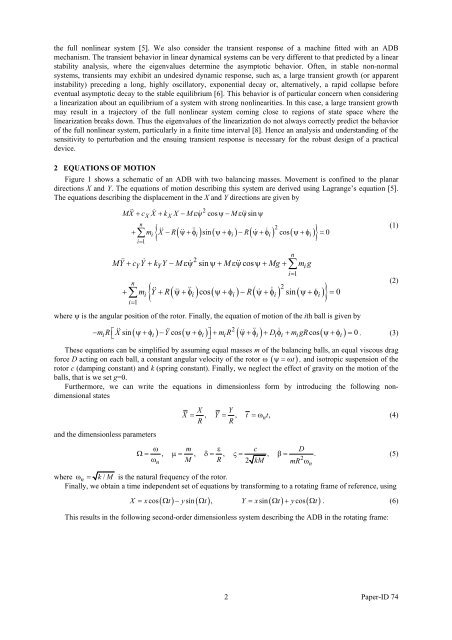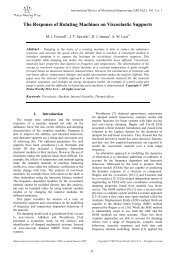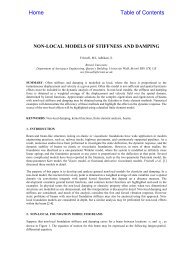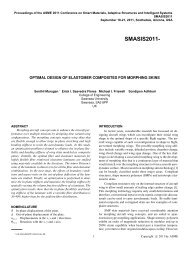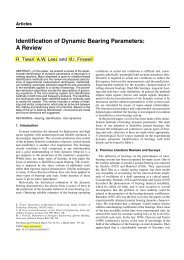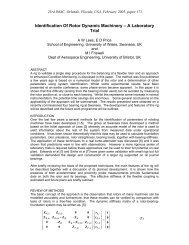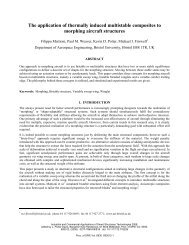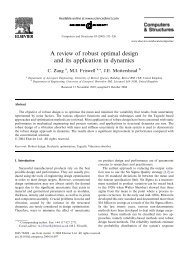The Stability of Automatic Ball Balancers (Paper ... - Michael I Friswell
The Stability of Automatic Ball Balancers (Paper ... - Michael I Friswell
The Stability of Automatic Ball Balancers (Paper ... - Michael I Friswell
Create successful ePaper yourself
Turn your PDF publications into a flip-book with our unique Google optimized e-Paper software.
the full nonlinear system [5]. We also consider the transient response <strong>of</strong> a machine fitted with an ADBmechanism. <strong>The</strong> transient behavior in linear dynamical systems can be very different to that predicted by a linearstability analysis, where the eigenvalues determine the asymptotic behavior. Often, in stable non-normalsystems, transients may exhibit an undesired dynamic response, such as, a large transient growth (or apparentinstability) preceding a long, highly oscillatory, exponential decay or, alternatively, a rapid collapse beforeeventual asymptotic decay to the stable equilibrium [6]. This behavior is <strong>of</strong> particular concern when consideringa linearization about an equilibrium <strong>of</strong> a system with strong nonlinearities. In this case, a large transient growthmay result in a trajectory <strong>of</strong> the full nonlinear system coming close to regions <strong>of</strong> state space where thelinearization breaks down. Thus the eigenvalues <strong>of</strong> the linearization do not always correctly predict the behavior<strong>of</strong> the full nonlinear system, particularly in a finite time interval [8]. Hence an analysis and understanding <strong>of</strong> thesensitivity to perturbation and the ensuing transient response is necessary for the robust design <strong>of</strong> a practicaldevice.2 EQUATIONS OF MOTIONFigure 1 shows a schematic <strong>of</strong> an ADB with two balancing masses. Movement is confined to the planardirections X and Y. <strong>The</strong> equations <strong>of</strong> motion describing this system are derived using Lagrange’s equation [5].<strong>The</strong> equations describing the displacement in the X and Y directions are given by2MX + c X + k X −M εψ cos ψ−MεψsinψX Xn∑ i i i i ii=12{ ( ) ( ) ( ) ( )}+ m X −R ψ + φ sin ψ+ φ − R ψ + φ cos ψ+ φ = 0n2MY + cYY + kYY −M εψ sin ψ+ M εψcosψ+ Mg + ∑ migi=1n(2)2+ ∑ mi{ Y + R( ψ+φ i) cos( ψ+φi) −R( ψ+φ i) sin ( ψ+φ i)} = 0i=1where ψ is the angular position <strong>of</strong> the rotor. Finally, the equation <strong>of</strong> motion <strong>of</strong> the ith ball is given by2−mR i ⎡X sin ( ψ+φi) −Y ⎣cos ( ψ+φ i) ⎤⎦+ mR i ( ψ+φ i) + Diφ i + mgR i cos( ψ+φ i)= 0 . (3)<strong>The</strong>se equations can be simplified by assuming equal masses m <strong>of</strong> the balancing balls, an equal viscous dragforce D acting on each ball, a constant angular velocity <strong>of</strong> the rotor ω ( ψ =ω t ) , and isotropic suspension <strong>of</strong> therotor c (damping constant) and k (spring constant). Finally, we neglect the effect <strong>of</strong> gravity on the motion <strong>of</strong> theballs, that is we set g=0.Furthermore, we can write the equations in dimensionless form by introducing the following nondimensionalstatesX YX = , Y , t nt,R= R=ω (4)and the dimensionless parametersω m ε c DΩ= , µ= , δ= , ς= , β= .ω22n M R kM mR ωnwhere ω n = k/M is the natural frequency <strong>of</strong> the rotor.Finally, we obtain a time independent set <strong>of</strong> equations by transforming to a rotating frame <strong>of</strong> reference, using( ) ( ) ( ) ( )X = xcos Ωt − ysin Ω t , Y = xsin Ω t + ycosΩ t . (6)This results in the following second-order dimensionless system describing the ADB in the rotating frame:(1)(5)2 <strong>Paper</strong>-ID 74


